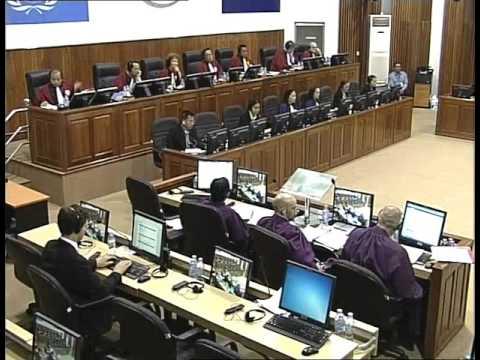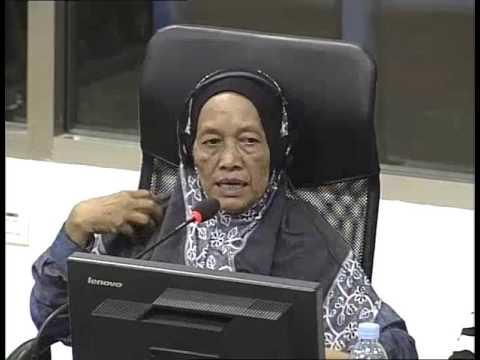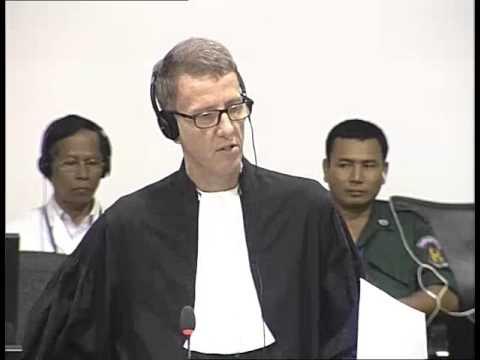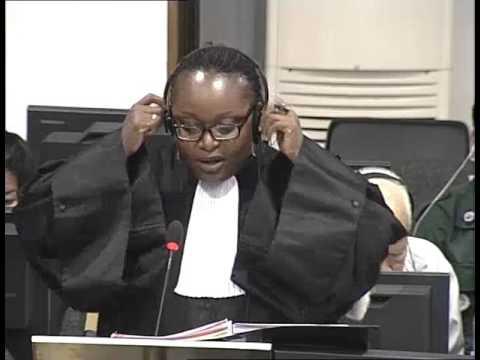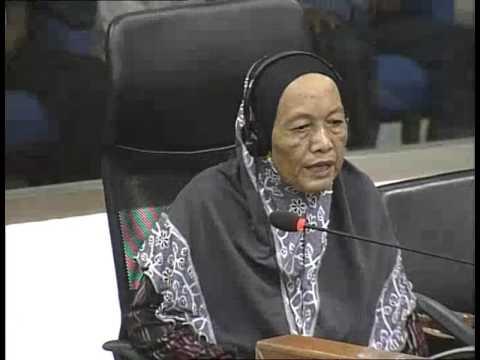Background and role
No Sates, of Cham origin, lived in Kampong Cham province’s Svay Khleang village in 1975.
1
Between 1975 and 1976, the Khmer Rouge relocated her to Khsach Prachheh Leu village and then to Trea village, where she was assigned to dig earth to build toilets.
2
No Sates testified before the Trial Chamber as a civil party in Case 002/02 about the restrictions on Cham cultural and religious practices, the rebellion by Cham people in Svay Khleang village, and the purges of Cham people and East Zone soldiers by Southwest Zone forces during the Khmer Rouge regime from 1975 to 1979.
3
Prohibitions on Cham cultural and religious practices
According to No Sates, after the fall of Phnom Penh in 1975, Cham people were not allowed to practice their religion or to pray within the mosque.
4
Mosques were shut down and observers were pressured to stop practicing Islam.
5
The Cham language and traditional clothing were prohibited.
6
People were only allowed to wear black trousers, skirts and shirts.
7
Korans were collected and burned.
8
Cham women could no longer have long hair or wear head scarves.
9
The prohibitions were communicated to the people at meetings held by the commune chief, village chief, deputy village chief and members of village committee.
10
Those who refused to follow the instructions would be considered as having betrayed Angkar and would be taken away.
11
When No Sates arrived at Khsach Prachheh Leu, she attended meetings once a month during which Cham people were told about the prohibitions on their cultural and religious practices.
12
“The meeting would take place once every month or even earlier than that and we were told not to speak Cham language. Our religion was abolished […] and we were not allowed to do any prayers. Angkar prohibited all of us from wearing head scarf or traditional clothes […] and we were instructed to cut our hair short, we were not allowed to practice, to use Korans; Angkar from the upper level ordered such prohibitions. I did not know who Angkar was, but I only knew that it was Angkar.”
Svay Khleang rebellion and crackdown
No Sates recalled a bloody rebellion by the Cham in Svay Khleang village in October 1975.
14
The uprising started at 7:00p.m. and lasted for one night and one day.
15
It arose from the fear that the Cham would continue to be arrested, detained, or killed.
16
She attributed the arrest of Cham religious leaders, intellectuals and professors including Hakims and Tuon to the rebellion.
17
Villagers including her father were armed with only knives, machetes and swords while Khmer Rouge cadres had different kinds of guns.
18
“There was no way that the rebellion would defeat the Khmer Rouge […] So, it was defeated. We surrendered and submitted to them”.
19
The fighting resulted in hundreds of casualties for the Cham, and some casualties for the Khmer Rouge forces.
20
After the rebellion was over, all the surviving Cham in Svay Khleang were told to leave and informed over loudspeaker that the Khmer Rouge wanted to search for enemies, and, if they did not leave, they would be considered enemies to Angkar.
21
The Khmer Rouge ordered No Sates to leave Savy Khleang for Khsach Prachheh Leu.
22
She was detained in a tobacco warehouse for one month and three days before being sent to Khsach Prachheh Leu,
23
where she was assigned to dig canals with only a ladle of gruel to eat after hard work.
24
Purges of Cham by Southwest Zone forces
When Southwest Zone forces arrived at Khsach Prachheh Leu around 1976 and 1977,
25
the “purge” operation began.
26
Cham people were collected and sent away to other locations within the province.
27
First the male Cham were sent away and then the village chief invited the female Cham to a meeting where they were told that they would be relocated to other villages.
28
Among the Cham evacuated were members of No Sates’s family, who were sent to Stueng Trang by boat.
29
She never saw them again.
30
While some Khmer people were also evacuated, they were sent to Roka Khnaor commune, and they were not executed.
31
No Sates was sent to Trea village along with a group of approximately 40 unmarried women from Khsach Prachheh Kandal village.
32
On her arrival, she was placed in a house with about 300 women from the surrounding areas.
33
The women were tied up and questioned by the Kroch Chmmar district chief Hor.
34
They were asked if they were Khmer or Cham and anybody who said that they were Cham was taken out of the line-up and escorted elsewhere by a soldier and then disappeared.
35
During the nine days No Sates was detained, she was forced one night to eat pork in order to convince the Khmer Rouge that she was Khmer.
36
Only the 30 women who insisted that they were Khmer remained.
37
After her release, No Sates was sent to work around Trea village, and one day in 1978 while she was working along the riverbank, she witnessed dead bodies floating in bags in the river including children.
38
The corpses got swollen and the sacks broke, and she could recognize one body of a person named Thol, whose throat was slashed.
39
Some bodies were soldiers from the East Zone whom she recognized from the uniform on them.
40
The Trial Chamber relied on No Sates’s testimony, among other evidence, in finding that: (i) the Communist Party of Kampuchea (CPK) in practice never implemented the right of freedom of religion and considered Islam to be “reactionary” and therefore “absolutely forbidden”;
41
(ii) in September and October 1975, following increasing restrictions on Cham religious and cultural practices, two Cham rebellions broke out and were suppressed by the CPK forces resulting in the deaths of a great number of Cham;
42
(iii) after the rebellions, the remaining Cham population was forcibly removed from the villages of Svay Khleang and Koh Phal;
43
(iv) a large number of Cham people from Kroach Chhmar district were arrested and detained at Trea Village Security Centre arbitrarily;
44
(v) their membership to the Cham group was verified, sometimes through beatings, and those who were deemed to be Cham were executed while some others were moved to other places and spared;
45
and (vi) Southwest Zone cadres took control of the East Zone between 1977 and 1978.
46
Statement of Suffering
“I cannot forget the experience that I went through during the Pol Pot regime. There are countless of events that I cannot recall. If I could recall them, I would tell you everything, tell you about the difficult time and the hardship that I went through. Sometimes, there was nothing to eat, we had to grab some grains from rice stalk in the field, we ground them secretly in order to eat it. Sometimes soldiers came to herd some people away, they burnt our belongings, they burnt blankets, and they destroyed rice and salt. When I look at other families who had their relatives survived, I felt so pity of myself. Sometimes, I had to sit down quietly and wept. I looked like a crazy person at that time. I pitied my younger siblings. I really pitied them. I recalled when they did not have any food to eat, they lied down on the ground, and they were so weak. I had to go out and search for food, for vegetables or leaves for them to eat. They were so skinny. Sometimes, I wanted to kill myself. I did not want to witness such a misery experienced by my siblings. Every time I recalled what happened in the past, it seems that my mind is not in my body anymore. Sometimes, my children try to comfort me but to me the memory is still vivid in my mind. I would exchange my life for food for my siblings and I keep asking the questions to myself: why my siblings including my mother were taken away and never returned? What was the purpose of making the Revolution? And would like to put these questions to any person responsible in this Court to give me the answers.”
47
Videos
